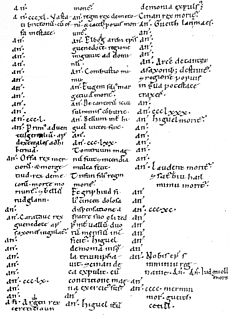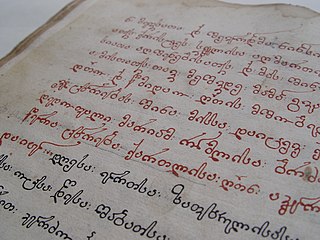Related Research Articles
Causantín or Constantín mac Cináeda was a king of the Picts. He is often known as Constantine I in reference to his place in modern lists of kings of Scots, but contemporary sources described Causantín only as a Pictish king. A son of Cináed mac Ailpín, he succeeded his uncle Domnall mac Ailpín as Pictish king following the latter's death on 13 April 862. It is likely that Causantín's reign witnessed increased activity by Vikings, based in Ireland, Northumbria and northern Britain. He died fighting one such invasion.
Constantine, son of Áed was an early King of Scotland, known then by the Gaelic name Alba. The Kingdom of Alba, a name which first appears in Constantine's lifetime, was situated in modern-day Scotland.
Macbeth was King of Scots from 1040 until his death. He ruled over the Kingdom of Alba.
Malcolm III was King of Scotland from 1058 to 1093. He was later nicknamed "Canmore". Malcolm's long reign of 35 years preceded the beginning of the Scoto-Norman age. Henry I of England and Eustace III of Boulogne were his sons-in-law, making him the maternal grandfather of Empress Matilda, William Adelin and Matilda of Boulogne. All three of them were prominent in English politics during the 12th century.
Cináed mac Maíl Coluim was King of Scots (Alba). The son of Malcolm I, he succeeded King Cuilén on the latter's death at the hands of Rhydderch ap Dyfnwal in 971.
Donald III, and nicknamed "Donald the Fair" or "Donald the White", was King of Scots from 1093–1094 and 1094–1097.
Malcolm II was King of the Scots from 1005 until his death. He was a son of King Kenneth II; the Prophecy of Berchán says that his mother was a woman of Leinster and refers to him as Forranach, "the Destroyer".
Olaf Guthfrithson or Anlaf Guthfrithson was a Viking leader who ruled Dublin and Viking Northumbria in the 10th century. He was the son of Gofraid ua Ímair and great-grandson of Ímar, making him one of the Uí Ímair. Olaf succeeded his father as King of Dublin in 934 and succeeded in establishing dominance over the Vikings of Limerick when he captured their king, Amlaíb Cenncairech, in 937. That same year he allied with Constantine II of Scotland in an attempt to reclaim the Kingdom of Northumbria which his father had ruled briefly in 927. The forces of Olaf and Constantine were defeated by the English led by Æthelstan at the Battle of Brunanburh in 937.

The Annales Cambriae is the title given to a complex of Cambro-Latin chronicles compiled or derived from diverse sources at St David's in Dyfed, Wales. The earliest is a 12th-century presumed copy of a mid-10th-century original; later editions were compiled in the 13th century. Despite the name, the Annales Cambriae record not only events in Wales, but also events in Ireland, Cornwall, England, Scotland and sometimes further afield, though the focus of the events recorded especially in the later two-thirds of the text is Wales.

The Battle of the Standard, sometimes called the Battle of Northallerton, took place on 22 August 1138 on Cowton Moor near Northallerton in Yorkshire. English forces under William of Aumale repelled a Scottish army led by King David I of Scotland.

The Annals of Ulster are annals of medieval Ireland. The entries span the years from 431 AD to 1540 AD. The entries up to 1489 AD were compiled in the late 15th century by the scribe Ruaidhrí Ó Luinín, under his patron Cathal Óg Mac Maghnusa, on the island of Senadh-Mic-Maghnusa, also known as Senad or Ballymacmanus Island, near Lisbellaw, on Lough Erne in the kingdom of Fir Manach (Fermanagh). Later entries were added by others.
Óengus son of Fergus, was king of the Picts from 732 until his death in 761. His reign can be reconstructed in some detail from a variety of sources. The unprecedented gains he made, and the legacy he left, mean Óengus can be considered the first king of what would become Scotland.
The Kingdom of Alba was the Kingdom of Scotland between the deaths of Donald II in 900 and of Alexander III in 1286, which then led indirectly to the Scottish Wars of Independence. The name is one of convenience, as throughout this period the elite and populace of the Kingdom were predominantly Pictish-Gaels or later Pictish-Gaels and Scoto-Norman, and differs markedly from the period of the House of Stuart, in which the elite of the kingdom were speakers of Middle English, which later evolved and came to be called Lowland Scots. There is no precise Gaelic equivalent for the English terminology "Kingdom of Alba", as the Gaelic term Rìoghachd na h-Alba means 'Kingdom of Scotland'. English-speaking scholars adapted the Gaelic name for Scotland to apply to a particular political period in Scottish history during the High Middle Ages.
Ciniod, Cináed or Cinadhon, son of Uuredech, was king of the Picts from 763 until 775.
Talorc son of Foith or son of Uuid was a king of the Picts from 641 to 653.
Alpín was king of the Picts from 726-728, together with Drest. The Pictish Chronicle king lists give Alpín and Drest a five-year joint rule.

The Georgian Chronicles is a conventional English name for the principal compendium of medieval Georgian historical texts, natively known as Kartlis Tskhovreba, literally "Life of Kartli", Kartli being a core region of ancient and medieval Georgia, known to the Classical and Byzantine authors as Iberia.

The Anglo-Saxon Chronicle is a collection of annals in Old English, chronicling the history of the Anglo-Saxons. The original manuscript of the Chronicle was created late in the 9th century, probably in Wessex, during the reign of Alfred the Great. Multiple copies were made of that one original and then distributed to monasteries across England, where they were independently updated. In one case, the Chronicle was still being actively updated in 1154.
Nobis or Novis is traditionally considered to have been a bishop of Meneva in the medieval Welsh kingdom of Dyfed.